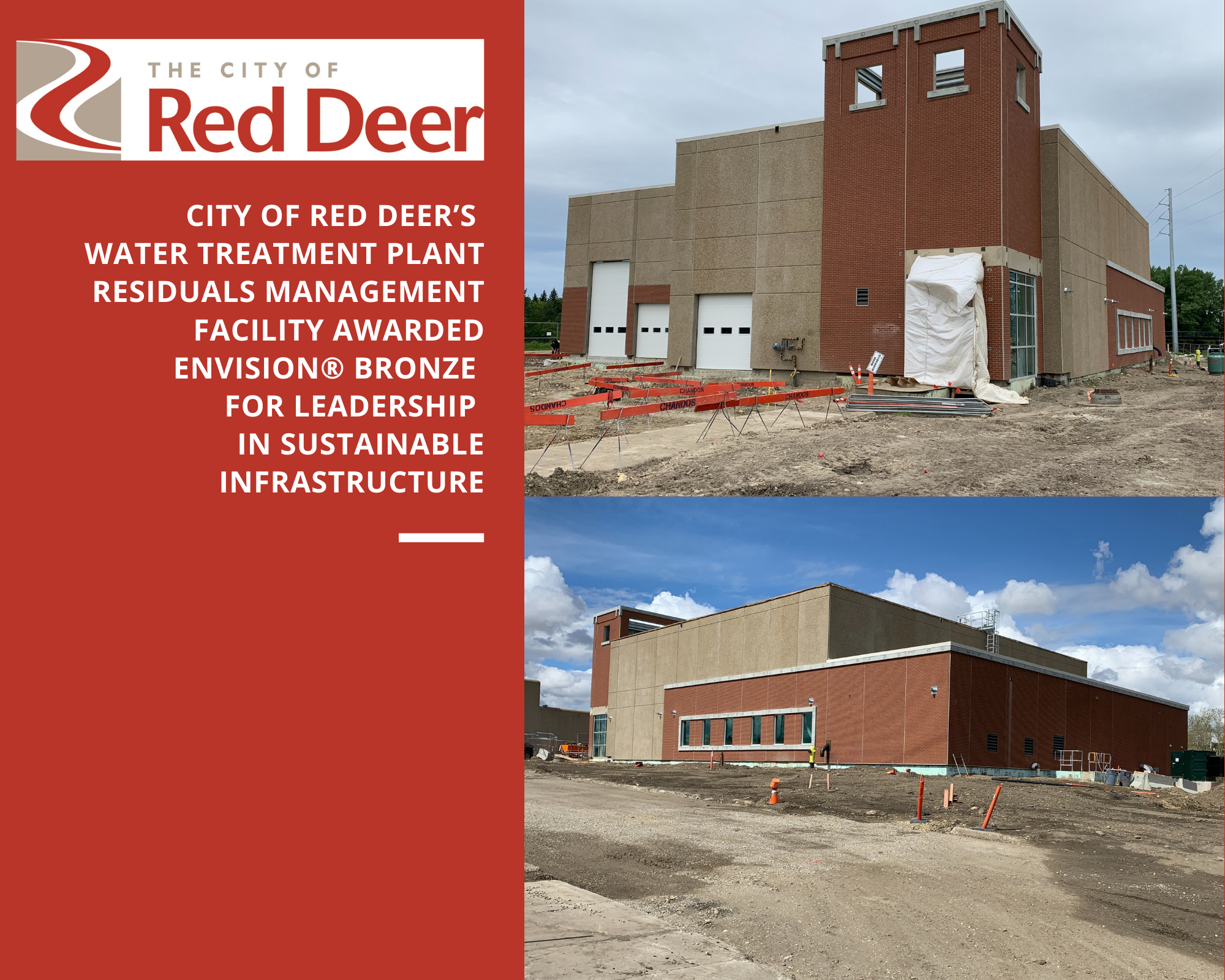
City of Red Deer’s Water Treatment Plant Residuals Management Facility
Awarded Envision® Bronze for Leadership in Sustainable Infrastructure
Home to more than 101,000 residents, the City of Red Deer, which is located in central Alberta, operates a conventional surface water treatment plant that draws water from the Red Deer River and provides clean drinking water to the city and its regional customers. The primary goal of the Water Treatment Plant (WTP) Residuals Management Facility (RMF) is to improve the quality of the waste stream from the clarification process at the WTP prior to its discharge into the Red Deer River. Improved treatment of the waste streams from the new WTP RMF will reduce the visible plume created by the current discharge, reduce solids sedimentation and associated impacts on fish habitats, improve the river’s aesthetics, and encourage recreational activities.
The project is being constructed on a now out-of-service water treatment plant and sludge dewatering facility. These facilities are being demolished to accommodate the new RMF.
The project team, comprised of staff from the City of Red Deer (owner), Associated Engineering Alberta Ltd. (Engineering Consultant), and Chandos Construction Ltd. (General Contractor), used Envision to guide the design and construction of the RMF, as well as its ongoing operations and maintenance. Envision helped the team develop a cost-effective and more resource-efficient facility and reduce the RMF’s environmental impacts.
KEY SUSTAINABILITY ACHIEVEMENTS / VERIFIED RESULTS
• Minimizing noise and vibration from plant operations was deemed to be a high-priority issue for the project to address. Several noise and vibration studies, including a 48-hour ambient noise and vibration monitoring survey and a noise and vibration assessment from an operating facility, were conducted to predict airborne, structure-borne and ground-borne noise and vibration that could be present during construction and when the project is fully operational. Studies found that the facility, when operational, could potentially exceed the recommended nighttime noise limit of 50 dBA at nearby residential developments. Therefore, changes were made to the project’s design to reduce noise levels to below this limit. For example, the project team reduced noise and vibration by adjusting the power levels of the facility’s HVAC (heating, ventilation, and air conditioning) system and using acoustic liners for the ductwork. Also, the centrifuge room’s concrete floor was separated from the outer walls and the rest of the floors to further reduce noise and vibrations during facility operations.
• Reducing operational energy consumption by 23.6% compared to industry norms. This was achieved by increasing the insulation in the facility’s roof, including heat recovery from exhaust air using a run-around hydronic loop, installing energy monitoring software, implementing automated lighting controls, and implementing the noise and vibration reduction strategies identified in the previous paragraph.
• Developing a comprehensive plan for long-term monitoring and maintenance. The RMF will be monitored and controlled using SCADA (supervisory control and data acquisition)—a control system architecture comprised of computers, intuitive graphical user interfaces, and networked data communications to improve operators’ abilities to monitor and control specific systems/equipment within the facility.
• Supporting sustainable procurement practices by aligning procurement with the City’s Environmental Sustainability Policy which encourages staff to minimize the environmental impact of the city’s infrastructure and employ environmentally sound operational practices. In addition, the project team developed a set of Sustainability Certification Project Requirements against which potential bidders were required to demonstrate their sustainability practices and commit to using suppliers that take into account the environmental, social, and economic impact of their products.
• Preventing surface and groundwater contamination by including several features and monitoring systems into the project’s design, including a rain garden and groundwater monitoring wells in response to soil contamination found at the site. A qualified aquatic environmental specialist was also brought on board to provide recommendations for instream construction activities.
Kingsford Amoah, City of Red Deer’s Environmental Planning Engineer and ENV SP Lead:
It is an honour for ISI to recognize the City of Red Deer Water Treatment Plant Residuals Management Facility project as a leader in sustainable infrastructure. Our drinking water and our environment are high priorities for the City. The project is not only a proactive step in our ongoing upgrades to our water treatment plant but also demonstrates the City’s environmental leadership and commitment to achieving environmental sustainability. The City worked closely with its Engineering Consultant, General Contractor and regulators: Alberta Environment and Parks, Fisheries and Oceans Canada, Transport Canada, Alberta Public Lands, and Alberta Culture and Tourism to make the project a reality.
Melissa Peneycad, ISI’s Managing Director:
The City of Red Deer should be lauded for its thoughtful and strategic use of Envision throughout project design and construction and to inform long-term operations and maintenance decisions as well. Furthermore, I commend the City of Red Deer for taking on the Envision challenge themselves, seeing Envision verification as an excellent opportunity to learn and build internal capacity around Envision and sustainable infrastructure practices more broadly. Congratulations to the City of Red Deer and its consultants and contractors for achieving Envision Bronze for the Water Treatment Plant Residuals Management Facility!
City of Red Deer Website
City of Red Deer Wastewater Services
Download the Project Profile announcement


